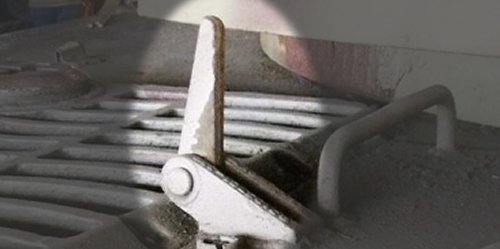Basic facts about "223"
Tiger "223" belonged to s.Pz.Abt.502. It was part of the large batch of new Tigers issued to them in mid 1943, bringing them up to strength as a full Tiger Battalion. After training in the grounds of a French chateau, these Tigers arrived at the Leningrad front on 23 July and immediately joined the 3rd battle of Lake Ladoga.
"223" was a standard Tiger. Therefore it had a single antenna base, on the hull roof's right side. It had no holders on the right wall of its hull, or chimney on the hull roof. The kit's instructions correctly tell you to remove these items.
Our knowledge of "223" comes from a single photo that shows it beside a destroyed KV-1 Russian tank. We can see only the rear and side of "223".
Optional features of "223"
Three different kinds of mantlet were being fitted to Tigers in early 1943, more or less at random. Two of them are provided in the kit. We can't see what kind was on "223".
Two different kinds of loader's hatch were fitted to Tigers, more or less at random. We can't see what kind was on "223".
S-mine launchers and headlamps were removable features of the Tiger, and were often absent. At the time of its photograph, Tiger "223" had its S-mine launchers fitted and its headlamps removed. The headlamps were supposed to be removed during combat.
It was very common to remove both of the front roadwheels from Tigers to prevent them scooping mud into the system. At the time of its photo, "223" had some damage to its wheels, possibly from a mine. The front right-hand roadwheel appears to be missing.
The full smoke-launcher system was installed on "223".
Time-related features of "223"
We can't see much of "223" in the photo, but since it's a standard Tiger, we can probably rely on the version timeline laid out in the book "Germany's Tiger Tanks".
"223" surely had no openings above the driver's visor. This kit includes an appropriate front wall without openings.
Given its build date, "223" must have had an engine cover with a triangular access panel. This kit includes an appropriate cover (J3) and calls it out correctly.
Given the date of its manufacture, "223" should have had the second type of Feifel filters, but the photo clearly shows the first type. They may have been swapped in from an older Tiger.
"223" had spare track holders on its turret, with two on the turret's right side and five on the left. This kit includes track holders.
"223" had a turret roof periscope. We know this because the loader's hatch, in the photo, is resting upon the periscope cover rather than the roof. A periscope is provided in the kit, but the instructions don't tell you to use it for "223". That is an error in the instructions.
Sprocket wheels were being manufactured with flat hubs at the time when "223" was built. That kind of hub is not supplied in the kit. We are given only an older, rounded hub.

When "223" was built, it was standard to fit the engine hatch with two legs, to prop it open for ventilation. This photo shows one of them. They are not provided in the kit.
When "223" was built, the outlet grilles on the rear deck had identical patterns. The factory was no longer making "mirrored" grilles. But "mirrored" grilles are the only ones provided in the kit.
"223" was built around the time when the old HL210 engine was being replaced by the HL230. We don't know which engine "223" had. The kit provides a starter adaptor plate for the HL210 only.
The two welded frames on the rear hull wall, where the mudflaps attach, were not present on "223". They are molded into the kit's rear wall and should be sanded off.
"223" had the final type of rear mudflap, with rectangular holes. Those are provided in the kit.
From its date of manufacture, we expect "223" to have two bolts flanking its hull MG.
"223" had the usual sheet-metal exhaust shields, and a cap (part S6) suspended over the exhaust outlets.